Samsung's Galaxy S 4: Introduction & Hands On
by Anand Lal Shimpi on March 14, 2013 7:30 PM EST- Posted in
- Smartphones
- Samsung
- Mobile
- Galaxy S 4

Since 2010 Samsung has grown to become not only the clear leader in the Android smartphone space, but the largest smartphone manufacturer in the world. Its annual iteration of the Galaxy S platform is now arguably one of the most widely anticipated smartphone launches each year.
Like clockwork, tonight Samsung announced the Galaxy S 4: a 5-inch 1080p smartphone, and the new flagship for the Galaxy brand. We just finished learning about the device and spent a short time playing around with it.
Most of the hardware specs are known quantities. The 5-inch Super AMOLED display features a 1080p resolution, for a pixel density of over 441 ppi. The chassis is plastic with a metallic looking rim around the edge. Like most Samsung devices, the Galaxy S 4 feels well built although the plastic construction makes it the polar opposite of HTC's One - and truthfully in a different league altogether. I don't personally believe Samsung's use of plastics is terrible, but it definitely doesn't lend itself to the same sort of remarkable designs we see from HTC or Apple. On the plus side the SGS4 feels very light (it's even lighter than the SGS3). The tradeoff between material feel and weight is one that has a spectrum of solutions. Samsung remains on prioritizing weight and cost, which is understandable given the success the company has seen thus far.
The SGS4 feels surprisingly comfortable in hand, partly due to weight and party due to the device's proportions. I didn't mind the size at all.
The Galaxy S 4 is available in two colors: white frost and black mist. I played with an international SGS4 variant in white frost.
| Smartphone Spec Comparison | ||||||
| Apple iPhone 5 | HTC One | Samsung Galaxy S 3 | Samsung Galaxy S 4 | |||
| SoC | Apple A6 1.3GHz | Snapdragon 600 1.7GHz | Snapdragon S4 1.5GHz | Exynos 5 Octa (1.6/1.2GHz) or Snapdragon 600 1.9GHz | ||
| DRAM/NAND/Expansion | 1GB LPDDR2, 16/32/64GB NAND | 2GB LPDDR2, 32/64GB NAND | 2GB LPDDR2, 16/32GB NAND, microSD | 2GB LPDDR3, 16/32/64GB NAND, microSD | ||
| Display | 4.0-inch 1136 x 640 LCD | 4.7-inch SLCD3 1080p, 468 ppi | 4.8-inch Super AMOLED 720p, 306 ppi | 5-inch Super AMOLED 1080p, 441 ppi | ||
| Network | 2G / 3G / 4G LTE Cat 3 | 2G / 3G / 4G LTE Cat 3 | 2G / 3G / 4G LTE Cat 3 | 2G / 3G / 4G LTE Cat 3 (depending on region) | ||
| Dimensions | 123.8mm x 58.6mm x 7.6mm | 137.4mm x 68.2mm x 4mm - 9.3mm | 136.6mm x 70.6mm 8.6mm | 136.6mm x 69.8mm x 7.9mm | ||
| Weight | 112g | 143g | 133g | 130g | ||
| Rear Camera | 8MP | 4MP w/ 2µm pixels | 8MP | 13MP | ||
| Front Camera | 1.2MP | 2.1MP | 1.9MP | 2MP | ||
| Battery | Internal 5.45 Wh | Internal 8.74 Wh | Removable 7.98 Wh | Removable 9.88 Wh | ||
| OS | iOS 6.1.2 | Android 4.1.2 | Android 4.1.2 | Android 4.2.2 | ||
| Connectivity | 802.11a/b/g/n, BT 4.0, USB 2.0, GPS/GNSS | 802.11ac/a/b/g/n + BT 4.0, USB2.0, GPS/GNSS, MHL, DLNA, NFC | 802.11a/b/g/n, BT 4.0, USB 2.0, NFC, GPS/GNSS, MHL | 802.11a/b/g/n/ac (HT80) + BT 4.0, USB 2.0 NFC, GPS/GNSS, IR LED, MHL 2.0 | ||
The back cover remains removable, as does the 9.88Wh battery:
Internally, there’s 2GB of memory and 16 - 64GB of on-board NAND, with a microSD card slot for optional storage expansion.
As expected, the SoC will vary depending on region. Samsung will offer either its own Exynos 5 Octa or a 1.9GHz quad-core Snapdragon SoC from Qualcomm. Given the clock speed and the timing, I would assume Samsung is talking about a Snapdragon 600 but the only official word from Samsung is the 1.9GHz quad-core Snapdragon. Update: Qualcomm has confirmed that this is a Snapdragon 600.
The Exynos 5 Octa side is a bit more interesting. Samsung is calling the SoC a 1.6GHz Octa-core part, but that appears to be the clock speed for the four Cortex A7 cores. The four Cortex A15 cores will run at up to 1.2GHz, which should help keep power consumption manageable. We’ve been wondering for a while what clock speeds we’d see the Cortex A15s run at in smartphones, and I believe this is the first line drawn in the sand. If we go back to Samsung’s ISSCC disclosure of Exynos 5 Octa power consumption, it looks like peak CPU power consumption should be somewhere around 2W - definitely better than what we saw from Exynos 5 Dual in the Nexus 10. Again, no surprises here given that we’re talking about a smartphone - it’s just interesting to see. Update: There seems to be some confusion as to whether or not the A7/A15 clocks are 1.6/1.2 or 1.2/1.6. I was told the former and that's what I wrote down, but it's entirely possible that the information given wasn't correct. I'm awaiting for further confirmation. Although 1.2GHz makes sense for a max clock for the A15s, 1.6GHz is a bit high for A7s if they're truly to be used to keep power consumption down. I can see it working either way.
Samsung isn’t ready to talk specifics about what SoCs will end up in what regions. We weren’t allowed to run any downloaded applications or benchmarks on the hardware at the event, nor were we told what SoCs were used in the demo hardware. Both SoCs should be good choices though.
Similarly, there’s no disclosure on what baseband silicon is being used although LTE support will be offered depending on the region. It’s highly likely that we’re looking at another MDM9x15 with a discrete applications processor (Snapdragon or Exynos 5 Octa). All of the expected wireless connectivity options are present including 802.11ac and BT 4.0. Samsung is claiming support global LTE roaming (up to six different bands) and FDD/TDD LTE.
As is the norm these days the Galaxy S 4 comes with both a front and rear facing camera. The front facing camera features a 2MP sensor and is capable of recording video at 1080p30. The rear facing camera sees a move to a 13MP sensor with flash. No word on the max aperture or focal length of the camera systems at this point.
The Galaxy S 4 will ship with Android 4.2.2. It will be available both internationally and in the US starting sometime in Q2 (Update: first shipments will be in April). US operators signed up to carry the Galaxy S 4 are AT&T, T-Mobile, Sprint, Verizon, Cricket and US Cellular.


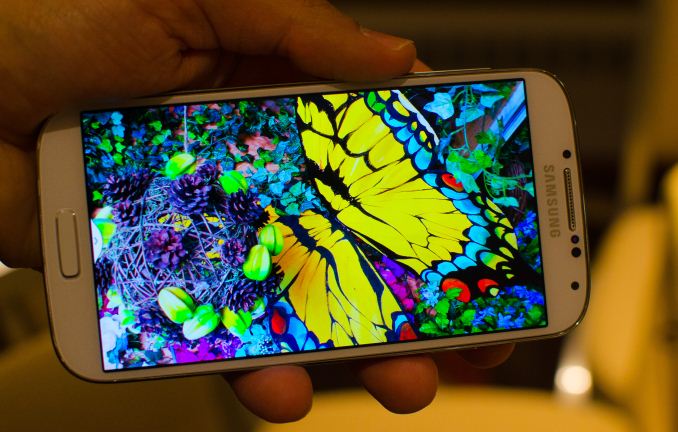
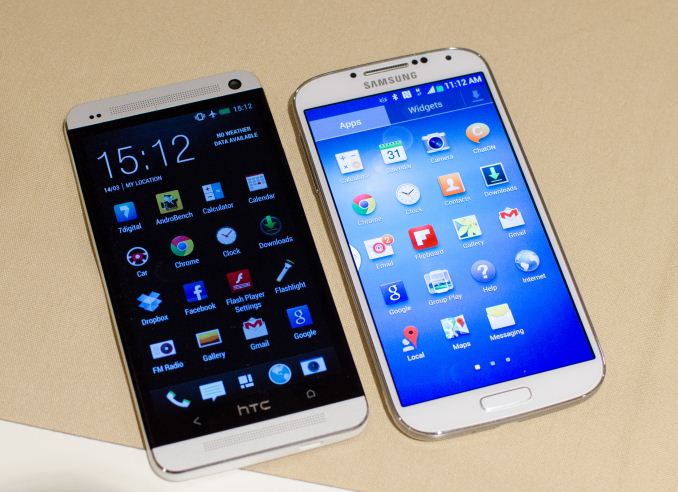

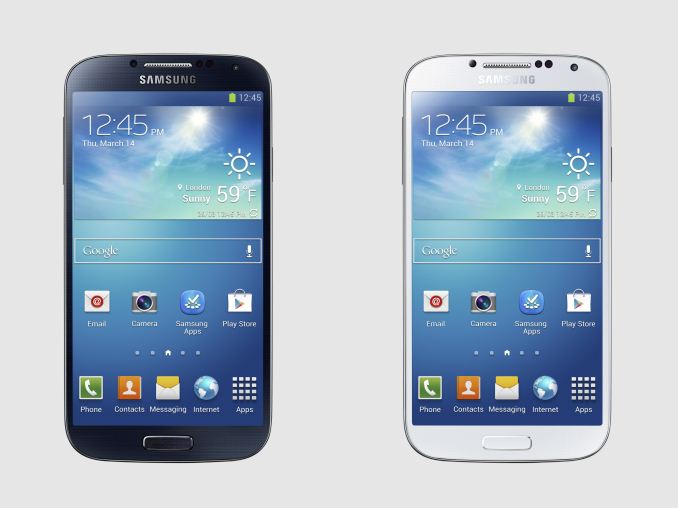
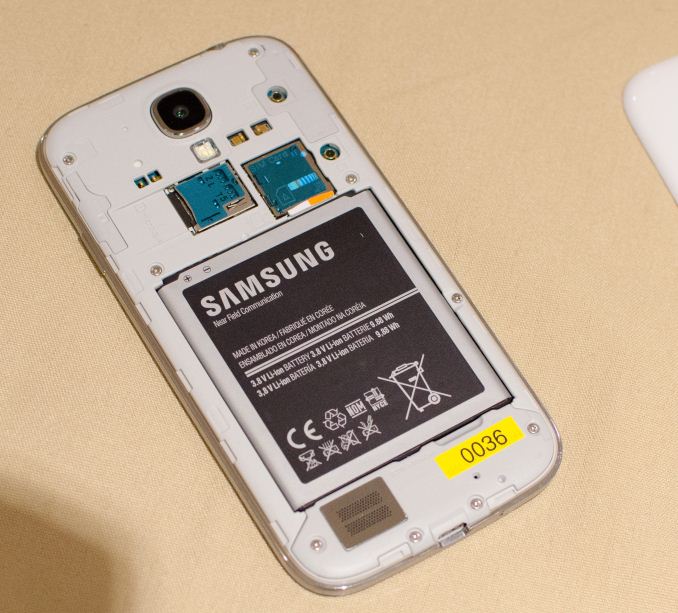
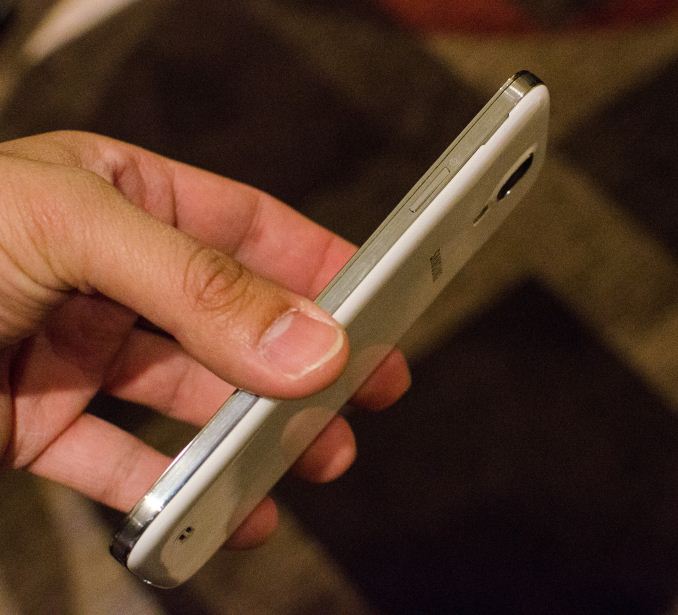















206 Comments
View All Comments
leexgx - Saturday, March 16, 2013 - link
none removable battery's are just no good if they do not use an 3000 or higher in the first place, the HTC One X is what a phone should not be (dead in 2-3 hours of screen on time, its dead in the day, i sold that phone in less then an month), they do tend to get bit iffy after 1-3 years (1.7 years been the avg as they expect you to upgrade your phone)tablets idly should be 3500 or bigger, but the Note2 seems to get by with the one it has (3300 i think)
Mihael Keehl - Sunday, March 24, 2013 - link
It depends on how much you charge them/over charger them. I have had the Apple iPhone 4S for a little over a year now and it's got about a solid 15% wear on it now, it'll probably be double that in another year and that's when my contract is up. Prior to that I had the Samsung and I couldn't deal with the battery issues it had, because it burned through the battery much faster. A swappable battery does have it's perks because 5%-10% wear isn't all that bad, but when it reaches over that and you're only using your phone 15%-20% less, you're essentially not getting what you paid for.A replaceable battery is exactly what the product needs, especially the ones whose screens are so enormous and bright. That shit will drain battery life and rather quickly.
kcsween - Tuesday, April 9, 2013 - link
I agree, I've never had a battery die on me within a year, never.new-paradigm - Tuesday, March 19, 2013 - link
You can't change battery mid call though. You can however plug in an emergency charger.ATBTCT - Wednesday, March 20, 2013 - link
Which you can go on Galaxy s4........RyuberUser - Friday, March 15, 2013 - link
Removable batteries are a cheap and effective way to power a phone. Me and my wife have the same phone (GS2), so when we go traveling on long trips we can just switch out batteries, and ridiculous amounts of media as needed. It's super convenient. Also, the weight of 2 extra batteries is still lighter than an emergency charger. and yes, the phone is off for less than 30 seconds. less wait time than most traffic lights... best features in any phone, as stated above, is the removable battery and expandable memory.Cobraflight - Saturday, March 16, 2013 - link
For you, maybe it's "massively overstated". For others, like me, it's important. How do I know it's important? Because I use my current phone with multiple batteries, and find it to be very useful to be able to carry one or more extra batteries in my pocket, and swap them out if the phone runs low. Your mileage may vary. If one phone satisfied everyone, there wouldn't be 100s of different phones out there.semo - Sunday, March 17, 2013 - link
It's Android. It needs regular restarting anyway! I find that Google Navigator crashes if you've used it more than once or twice between restarts.Whatever your use, I think a removable battery is important. I also like high quality plastics instead of metal on mobile devices and expandable memory. I hate the size though and prefer 4" to 4.5" screens instead.
ATBTCT - Sunday, March 17, 2013 - link
You people are bitching about having choices....You can external charger and USB OTG on this phone too. About the size, all I can say is that this phone is the same size as HTC ONE but with bigger screen. Those bezels can still be made smaller though, so manufacturers can fit bigger and bigger screen into smaller phones.ofladrt - Saturday, May 18, 2013 - link
I put a Gorilla Gadgets 4500 mAh battery with extended battery cover on my S3 and it lasts for two days easily, including using it as a golf course gps for 18 holes with long screen times. I would never go back to an ordinary battery.